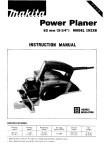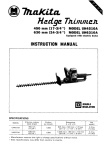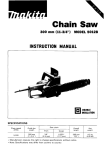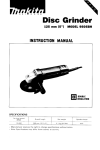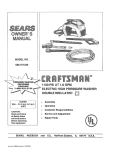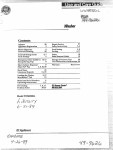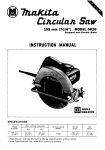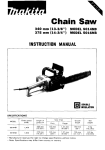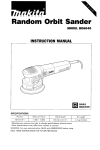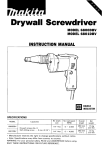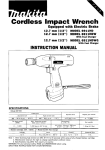Download Makita CURVED PLANER 1001 Instruction manual
Transcript
Curved Planer 82 mm (3-1/4") MODEL 1001 INSTRUCTION MANUAL Planing w i d t h 82 mm 13~114") Planing depth N o load speed IRPMI 3 mm 1118"l 12,000 Overall length 370 mm 1,14~1/2"1 Net weight 6.0 kg 113.2 lbsl IMPORTANT SAFETY INSTRUCTIONS WARNING: When using electric tools, basic safety precautions should always be followed t o reduce the risk of fire, electric shock, and personal injury, including the following: READ ALL INSTRUCTIONS. 1. KEEP WORK AREA CLEAN. Cluttered areas and benches invite injuries. 2. CONSIDER WORK AREA ENVIRONMENT. Don't use power tools in damp or wet locations. Keep work area well lit. Don't expose power tools t o rain. Don't use tool in presence of flammable liquids or gases. 3. KEEP CHILDREN AWAY. All visitors should be kept away from work area. Don't let visitors ccntact tool or extension cord. 4.STORE IDLE TOOLS. When not in use, tools should be stored in dry, and high or locked-up place - out of reach of children. 5. DON'T FORCE TOOL. It will do the job better and safer at the rate for which it was intended. 6. USE RIGHT TOOL. Don't force small tool or attachment t o do the job of a heavy-duty tool. Don't use tool for purpose not intended. 7. DRESS PROPERLY. Don't wear loose clothing or jewelry. They can be caught in moving parts. Rubber gloves and non-skid footwear are recommended when working outdoors. Wear protective hair covering t o contain long hair. 8.USE SAFETY GLASSES. Also use face or dust mask if cutting operation is dusty. 9. DON'T ABUSE CORD. Never carry tool by cord or yank it t o disconnect from receptacle. Keep cord from heat, oil, and sharp edges. IO. SECURE WORK. Use clamps or a vise t o hold work. It's safer than using your hand and it frees both hands t o operate tool. 1 1 . DON'T OVERREACH. Keep proper footing and balance at all times. 12. MAINTAIN TOOLS WITH CARE. Keep tools sharp and clean for better and safer performance. Follow instructions for lubricating and changing accessories. Inspect tool cords periodically and if damaged, have repaired by authorized service facility. Inspect extension cords periodically and replace if damaged. Keep handles dry, clean, and free from oil and grease. 13. DISCONNECT TOOLS. When not in use, before servicing, and when changing accessories, such as blades, bits, cutters. 14.REMOVE ADJUSTING KEYS AND WRENCHES. Form habit of checking t o see that keys and adjusting wrenches are removed from tool before turning it on. 15. AVOID UNINTENTIONALSTARTING. Don't carry plugged-in tool with finger on switch. Be sure switch is OFF when plugging in. 16. OUTDOOR USE EXTENSION CORDS. When tool is used outdoors, use only extension cords intended for use outdoors and so marked. L 17. STAY ALERT. Watch what you are doing, use common sense. Don’t operate tool when you are tired. 18. CHECK DAMAGED PARTS. Before further use of the tool, a guard or other part that is damaged should be carefully checked t o determine that it will operate properly and perform its intended function. Check for alignment of moving parts, binding of moving parts, breakage of parts, mounting, and any other conditions that may affect its operation. A guard or other part that is damaged should be properly repaired or replaced by an authorized service center unless otherwise indicated elsewhere in this instruction manual. Have defective switches replaced by authorized service center. Don’t use tool if switch does not turn it on and off. 19. GUARD AGAINST ELECTRIC SHOCK. Prevent body contact with grounded surfaces. For example; pipes, radiators, ranges, refrigerator enclosures. 20. PROPER GROUNDING. This tool should be grounded while in use t o protect the operator from electric shock. 21. EXTENSION CORDS: Use only three-wire extension cords which have threeprong grounding-type plugs and three-pole receptacles which accept the tool’s plug. Replace or repair damaged or worn cord immediately. VOLTAGE WARNING: Before connecting the tool t o a power source (receptacle, outlet, etc.) be sure the voltage supplied is the same as that specified on the nameplate of the tool. A power source with voltage greater than that specified for the tool can result in SERIOUS INJURY t o the user - as well as damage t o the tool. If in doubt, DO NOT PLUG IN THE TOOL. Using a power source with voltage less than the nameplate rating is harmful t o the motor. 3 ADDITIONAL SAFETY RULES 1. Rags, cloth, cord, string and the like should never be left around the work area. 2. Avoid cutting nails. Inspect for and remove all nails from the workpiece before operation. 3. Handle the blades very carefully. 4. Be sure the blade installation bolts are securely tightened before operation. 5. Hold the tool firmly with both hands. 6. Keep hands away from rotating parts. 7. Before using the tool on an actual workpiece, let it run for a while. Watch for vibration or wobbling that could indicate poor installation or a poorly balanced blade. 8. Make sure the blade is not contacting the workpiece before the switch is turned on. 9. Wait until the blade attains full speed before cutting. IO. Keep at least 200 m m (8") away from the tool at all times. 1 1 . Always switch off and wait for the blades t o come t o a complete stop before any adjusting. 12. Never stick your finger into the chip chute. Chute may jam when cutting damp wood. Clean out chips with a stick. 13. Do not leave the tool running. Operate the tool only when hand-held. 14. When leaving the planer, switch off and set it with the front base up on a wooden block, so that the blades do not contact anything. 15. Always change both blades or covers on the drum, otherwise the resulting imbalance will cause vibration and shorten tool life. SAVE THESE INSTRUCTIONS. 4 Removing or installing planer blades WARNING : Always be sure that the tool is switched off and unplugged before removing or installing the blades. To remove the blades on the drum, unscrew the three installation bolts with the socket wrench. The drum cover comes off together with the blades. To install the blades, first clean out all chips or foreign matter adhering to the drum or blades. Use blades of the same dimensions and weight, or drum oscillationhibration will result, causing poor planing action and, eventually, tool breakdown. I 1 Place the blade on the gauge base so that the blade edge i s perfectly flush with the inside edge of the gauge plate. Place the adjusting plate on the blade, then simply press in the heel of the adjusting plate flush with the back side of the gauge base and tighten the two screws on the adjusting plate. Now slip the heel of the adjusting plate into the drum groove, then fit the drum cover on it. Tighten the three installation bolts evenly and alternately with the socket wrench. Eo1t Adjusting p l a t e d I WARN ING : Tighten the blade installation bolts carefully when attaching the blades to the tool. A loose installation bolt can be dangerous. Always check to see they are tightened securely. 5 Adjusting depth of cut Depth of cut may be adjusted by simply turning the knob on the front of the tool. Adjusting front base 1. To create a curved surface, loosen the wing nut. For a concave planing job, raise the front base; for a convex planing job, lower the front base. In either case, the front base must be aligned with the cutting line. Then tighten the wing nut securely. NOTE : As explained later, although the objective is to cut until the cutting line is eventually reached, the planing must take place gradually. 6 I I Convex Cutting line I I - w \ WlnO nut Concave Cutting line \ 2. To create a flat surface, loosen the wing nut after setting the tool on a level surface. Turn the front knob on the tool until the front base is perfectly level with the rear base. Then tighten the wing nut securely. I F Wing n u t Switch action To start the tool, simply pull the trigger. Release the trigger to stop. For continuous operation, pull the trigger and then push in the lock button. To stop the tool from the locked position, pull the trigger fully, then release it. WARNING: Before plugging in the tool, always check to see that the trigger switch actuates properly and returns to the "OFF" position when released. Planing operation First, rest the tool front base flat upon the workpiece surface without the blades making any contact. Switch on and wait until the blades attain full speed. Then move the tool gently forward. Apply pressure on the front of tool a t the start of planing, and a t the back a t the end of planing. The speed and depth of cut determine the kind of finish. The power planer keeps cutting a t a speed that will not result in jamming by chips. For rough cutting, the depth of cut can be increased, while for a good finish you should reduce the depth of cut and advance the tool more slowly. 7 NOTE : *When beginning the planing of a flat workpiece to obtain eventually a convex shape, first take down both ends of the workpiece, gradually planing until the ultimate convex shape is achieved. *When beginning the planing of a flat workpiece to obtain eventually a concave shape, first take down the middle of the workpiece, gradually planing until the ultimate concave shape i s achieved. I First take down both ends of the workpiece F i r s t take down the middle of the workpiece Shiplappingor corner cuts (flush cuts) When performing the shiplapping or corner cuts (flush cuts up against a wall), remove the wing bolt to take off the drum cover, allowing flush-sidework. NOTE : Corner cuts (flush cuts up against a wall) are impossible, of course, if the tool cannot be moved forward or backward because of a wall or something blocking the tool path. WARNING : With the drum cover removed for corner cuts (flush cuts) or shiplapping, be very careful not to touch the drum/blades or allow your clothing to be caught during operation. After performing the shiplapping or corner cuts (flush cuts), ALWAYS RE-INSTALL THE DRUM COVER AND TIGHTEN THE WING BOLT SECURELY. Never forget to switch off and unplug the tool, and wait for the blades to come to a complete stop before re-installingthe drum cover. 8 Sharpening planer blades I Always keep your blades sharp for the best performance possible. Use the sharpening holder to remove nicks and produce a fine edge. First, loosen the two wing nuts on the holder and insert the blades (A) and (B), so that they contact the sides ( C ) and (D). Then tighten the wing nuts. Immerse the dressing stone in water for 2 or 3 minutes before sharpening.' Hold the holder so that the blades both contact the dressing stone for simultaneous sharpening a t the same angle. 9 MAINTENANCE CAUTION : Always be sure that the tool is switched off and unplugged before attempting to perform inspection or maintenance. Replacingcarbon brushes Remove and check the carbon brushes regularly. Replace when they wear down to the limit mark. Keep the carbon brushes clean and free to slip in the holders. Both carbon brushes should be replaced a t the same time. Use only Makita carbon brushes. / Limit mark Use a screwdriver to remove the brush holder caps. Take out the worn carbon brushes, insert the new ones and secure the brush holder caps. To maintain product SAFETY and RELIABILITY, repairs, any other maintenance or adjustment should be performed by Makita Authorized or Factory Service Centers, always using Makita replacement parts. 10 ACCESSORIES CAUTION: These accessories or attachments are recommended for use with your Makita tool specified in this manual. The use of any other accessories or attachments might present a risk of injury to persons. The accessories or attachments should be used only in the proper and intended manner. 0 Planer blade (Material : Tungsten-carbide) Width : 82 mm (3-1/4") Part No. 793007-0 Planer blade Width : 82 mm (3-1/4") Part No. 793004-6 0 Sharpening holder assembly Part No. 123004-6 0 Socket wrench Part No. 782209-3 0 Screwdriver Part No. 783002-8 0 0 0 0 Blade gauge assembly Part No. 123062-2 Dressing stone Part No. 794061-7 Steel carrying case Part No. 181840-6 11 Jan 26-89 EN 82 mm (3-1/4") CURVED PLANER Model 1001 Note The switch, noise suppressor and other part configuratlons may differ from country to country 12 MODEL 1 0 0 1 z:, Jan - 2 6 - ' 8 9 EN DESCRIPTION ITEM NO NO USED 33 34 35 36 31 38 3Y 40 41 42 43 44 45 46 41 48 49 50 51 52 53 54 55 56 51 58 59 60 61 62 63 64 65 1 1 DESCRIPTION MACHINE ~ 1 2 3 4 5 6 1 8 9 10 11 12 13 14 15 16 17 18 19 20 21 22 23 24 25 26 21 28 29 30 31 32 4 1 1 1 1 1 1 2 1 1 1 6 2 4 2 1 1 1 I 2 1 1 2 I 2 2 4 1 1 1 1 1 - Pan Head Screw M 5 x 2 5 IWith Washer1 Bracket Ball Bearing 6200LLB Fan 80 ARMATURE ASSEMBLY 71 !With lfem 3 Flaf Washer 1 2 Ball Bearing 6201LLB Pan Head Screw M 5 x 6 0 IWifh Washer) FIELD ASSEMBLY Rubber Pin 6 Rubber Pin 4 Hex Flange Head Bolt M 6 x 1 7 Drum Plate Pan Head Screw M 4 x 5 Adlust Plate Drum Ball Bearing 600322 Rubber Pin 6 Cord Pan Head Screw M 4 x 1 4 IWith Washerl Strain Relief Cord Guard lnsulal~onWasher Main Frame Carbon Brush Brush Holder Cap Rivet 0 5 Wing Bo11 M 5 x 1 0 Spr~ngWasher 5 Drum Cover spring P,n 8 Name Plate 80 ___ 1 1 1 Set Bo11 M 8 Knob 50 Flaf Washer I O Noise Suppressor 1 1 Swttch Pan Head Screw M 4 x 8 IWith Washer1 Handle Cover Countersunk Head Screw M 4 x 3 0 IWith Washer] Pan Head Screw M 4 x 3 0 !With Washeri Bell cover Poly V Belt 6 285 V Pulley 6 23L Pan Head Screw M 5 x 1 0 IWith Washer1 Bearing Retainer 44 V Pulley 6 - 3 0 Pan Head Screw M 4 x 2 5 IWNth Washer) D W tiouslny ~ Ball Bearing 6001LLB Rubber Pin 4 1 Retaining Ring R 1 1 Wing Nu! M 8 Spring Washer 8 F l a f Washer 8 Bellows 1 1 3 2 1 1 1 2 1 1 4 1 1 1 2 4 1 1 1 1 1 1 1 - 28 PreSSwe Plate Pan Head Screw M 4 x 1 0 IWith Washer1 From B o x Compression Sprinq 1 1 Rubber Pdckinq Sprinq Pin 5 24 :roll, Base :hip Cover >an Head Screw M 5 x 1 4 !With Washerl Note The switch noise suppressor and other part spechcations may differ from country 10 country 13 14 Makita Corporation 3-11-8, Sumiyoshi-cho, Anjo, Aichi 446 Japan 883000A0 PRINTED IN JAPAN I991 - 1 0 E

















